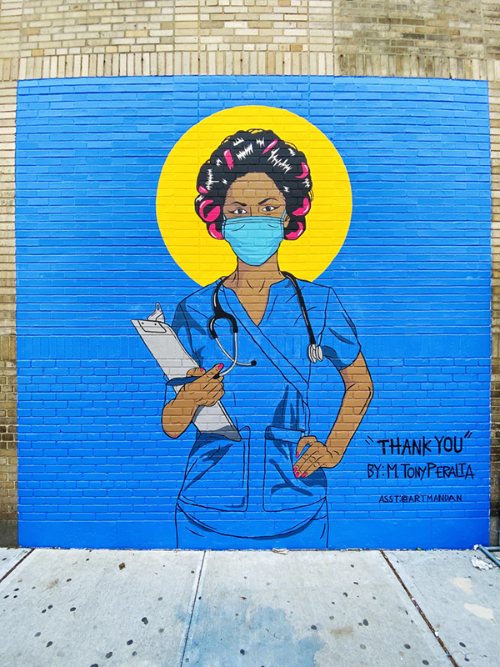Giving Thanks: M. Tony Peralta
Thanksgiving in the United States is meant to be a day when we express gratitude for our blessings. I am still grateful for the doctors and nurses who valiantly served our communities during the pandemic of 2019 to 2021. Some people, like artist M. Tony Peralta, expressed their thanks by making art at the height of the pandemic.
 |
| M. Tony Peralta (born 1974, United States), Thank You (Nurse with Rollers), New York Presbyterian Columbia Medical Center, 630 West 168th Street, Washington Heights, New York, 2020. House paint, 11'9 ¾" x 8'2 ⅜” (3.6 x 2.5 meters). Image courtesy of the artist. © 2024 M. Tony Peralta. (8S-30486) |
Thank You (Nurse with Rollers), from Peralta's Rolos and Icons series honoring Latinx women, is a tribute to healthcare workers during the COVID-19 pandemic. The series, which features such historical figures as Frida Kahlo in hair rollers, is meant to represent heroes in a relatable way. As a Dominican American, women wearing hair rollers is a familiar sight from Peralta's community.
Peralta first shared the nurse image on social media. He received such positive feedback that he created and sold t-shirts with the design, donating part of the proceeds to a coronavirus relief fund. The artist subsequently conceived of the nurse image as a mural. Officials at New York Presbyterian Columbia Medical Center in Washington Heights embraced the idea and offered the artist a wall for the work. Peralta chose a wall near the emergency room entrance. Along with his assistant, Peralta finished the mural in one day.
The art form of graffiti has been around since the ancient world. It has been found in ancient Roman cities such as Pompeii and has been discovered in ancient Mayan religious sites. In both cultures it was illegal to deface public buildings, but the art form was also an important means of communication. Contemporary graffiti evolved in American urban areas starting in the 1960s. It spans all racial and economic groups. Graffiti on public buildings, housing, and public transportation in American cities has spread as a cultural phenomenon around the world since the "renaissance" of graffiti art in the 1980s.
The first ever gallery exhibition of graffiti artists occurred in 1973 at Razor Gallery in New York City. The exhibit featured the work of artists in the United Graffiti Artists collective. In 1983, the Sidney Janis Gallery in New York brought graffiti art to the commercial art world with the landmark exhibition Post-Graffiti. While many early artists were self-taught, today graffiti can be a steppingstone to art training and careers as professional street artists.
A native of New York City, Peralta grew up with both Dominican culture and an interest in American art. He is an artist and designer who combines influences from Pop Art and hip-hop culture in his paintings, mixed-media works, and screen printing. Understanding the need to balance diverse cultures in artistic representations, Peralta often depicts aspects of Latin American experiences. He engages with contemporary audiences through his social media presence and his website The Peralta Project.
Correlations to Davis Programs: Engaging with Public Art; Explorations in Art 2E Grade 6: 3.4; Experience Art: 3.2, 7.1; A Community Connection 2E: 8.4; A Global Pursuit 2E: 4.4; The Visual Experience 4E: 11.9; Experience Painting: chapter 8

Comments